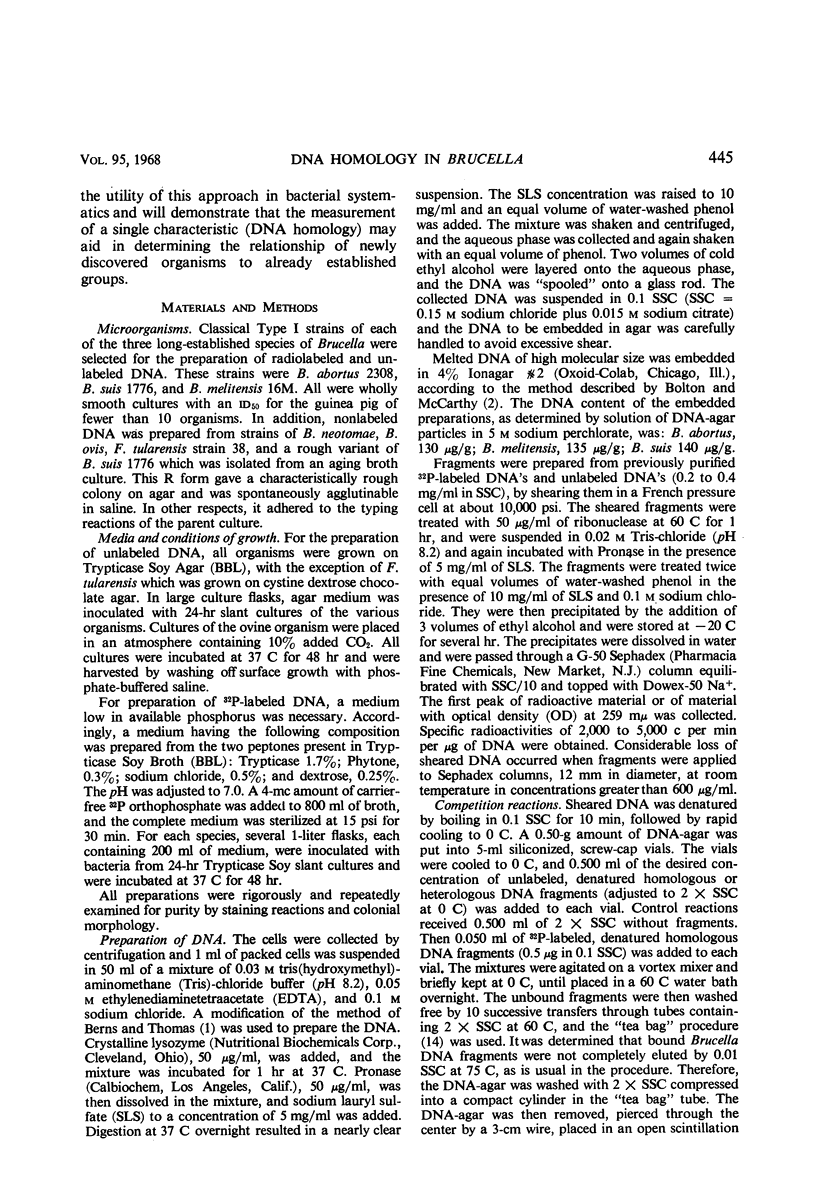Abstract
Deoxyribonucleic acids (DNA's) extracted from organisms presently placed in the genus Brucella (B. abortus, B. melitensis, B. neotomae, and B. suis) possessed very similar polynucleotide sequences. Unlabeled, single-stranded DNA fragments from B. abortus, B. melitensis, B. neotomae, and B. suis were equally effective in competing with the interaction of corresponding radiolabeled, single-stranded DNA fragments with their homologous DNA-agars. Unlabeled fragments of B. ovis, however, did not compete as effectively as the homologous, unlabeled DNA's, and this organism, therefore, had a detectably different polynucleotide composition. The mole percentages of guanine plus cytosine in Brucella DNA's (56 to 58%) were also similar. DNA's from Francisella tularensis, Escherichia coli, and the slow loris did not compete.
Full text
PDF




Selected References
These references are in PubMed. This may not be the complete list of references from this article.
- BERNS K. I., THOMAS C. A., Jr ISOLATION OF HIGH MOLECULAR WEIGHT DNA FROM HEMOPHILUS INFLUENZAE. J Mol Biol. 1965 Mar;11:476–490. doi: 10.1016/s0022-2836(65)80004-3. [DOI] [PubMed] [Google Scholar]
- BOLTON E. T., McCARTHY B. J. A general method for the isolation of RNA complementary to DNA. Proc Natl Acad Sci U S A. 1962 Aug;48:1390–1397. doi: 10.1073/pnas.48.8.1390. [DOI] [PMC free article] [PubMed] [Google Scholar]
- BUDDLE M. B. Studies on Brucella ovis (n.sp.), a cause of genital disease of sheep in New Zealand and Australia. J Hyg (Lond) 1956 Sep;54(3):351–364. doi: 10.1017/s0022172400044612. [DOI] [PMC free article] [PubMed] [Google Scholar]
- Brenner D. J., Martin M. A., Hoyer B. H. Deoxyribonucleic acid homologies among some bacteria. J Bacteriol. 1967 Aug;94(2):486–487. doi: 10.1128/jb.94.2.486-487.1967. [DOI] [PMC free article] [PubMed] [Google Scholar]
- COWIE D. B., MCCARTHY B. J. HOMOLOGY BETWEEN BACTERIOPHAGE LAMBDA DNA AND E. COLI DNA. Proc Natl Acad Sci U S A. 1963 Sep;50:537–543. doi: 10.1073/pnas.50.3.537. [DOI] [PMC free article] [PubMed] [Google Scholar]
- Gerloff R. K., Ritter D. B., Watson R. O. DNA homology between the meningopneumonitis agent and related microorganisms. J Infect Dis. 1966 Apr;116(2):197–202. doi: 10.1093/infdis/116.2.197. [DOI] [PubMed] [Google Scholar]
- HYER B. H., MCCARTHY B. J., BOLTON E. T. A MOLECULAR APPROACH IN THE SYSTEMATICS OF HIGHER ORGANISMS. DNA INTERACTIONS PROVIDE A BASIS FOR DETECTING COMMON POLYNUCLEOTIDE SEQUENCES AMONG DIVERSE ORGANISMS. Science. 1964 May 22;144(3621):959–967. doi: 10.1126/science.144.3621.959. [DOI] [PubMed] [Google Scholar]
- Heberlein G. T., De Ley J., Tijtgat R. Deoxyribonucleic acid homology and taxonomy of Agrobacterium, Rhizobium, and Chromobacterium. J Bacteriol. 1967 Jul;94(1):116–124. doi: 10.1128/jb.94.1.116-124.1967. [DOI] [PMC free article] [PubMed] [Google Scholar]
- Kingsbury D. T. Deoxyribonucleic acid homologies among species of the genus Neisseria. J Bacteriol. 1967 Oct;94(4):870–874. doi: 10.1128/jb.94.4.870-874.1967. [DOI] [PMC free article] [PubMed] [Google Scholar]
- LACY S., GREEN M. BIOCHEMICAL STUDIES ON ADENOVIRUS MULTIPLICATION. VII. HOMOLOGY BETWEEN DNA'S OF TUMORIGENIC AND NONTUMORIGENIC HUMAN ADENOVIRUSES. Proc Natl Acad Sci U S A. 1964 Oct;52:1053–1059. doi: 10.1073/pnas.52.4.1053. [DOI] [PMC free article] [PubMed] [Google Scholar]
- MARMUR J., DOTY P. Determination of the base composition of deoxyribonucleic acid from its thermal denaturation temperature. J Mol Biol. 1962 Jul;5:109–118. doi: 10.1016/s0022-2836(62)80066-7. [DOI] [PubMed] [Google Scholar]
- MCCARTHY B. J., BOLTON E. T. An approach to the measurement of genetic relatedness among organisms. Proc Natl Acad Sci U S A. 1963 Jul;50:156–164. doi: 10.1073/pnas.50.1.156. [DOI] [PMC free article] [PubMed] [Google Scholar]
- MCCARTHY B. J., HOYER B. H. IDENTITY OF DNA AND DIVERSITY OF MESSENGER RNA MOLECULES IN NORMAL MOUSE TISSUES. Proc Natl Acad Sci U S A. 1964 Oct;52:915–922. doi: 10.1073/pnas.52.4.915. [DOI] [PMC free article] [PubMed] [Google Scholar]
- Martin M. A., Hoyer B. H. Thermal stabilities and species specificities of reannealed animal deoxyribonucleic acids. Biochemistry. 1966 Aug;5(8):2706–2713. doi: 10.1021/bi00872a030. [DOI] [PubMed] [Google Scholar]
- McGee Z. A., Rogul M., Falkow S., Wittler R. G. The relationship of Mycoplasma pneumoniae (Eaton agent) to Streptococcus MG: application of genetic tests to determine relatedness of L-forms and PPLO to bacteria. Proc Natl Acad Sci U S A. 1965 Aug;54(2):457–461. doi: 10.1073/pnas.54.2.457. [DOI] [PMC free article] [PubMed] [Google Scholar]
- Ritter D. B., Gerloff R. K. Deoxyribonucleic acid hybridization among some species of the genus Pasteurella. J Bacteriol. 1966 Dec;92(6):1838–1839. doi: 10.1128/jb.92.6.1838-1839.1966. [DOI] [PMC free article] [PubMed] [Google Scholar]
- SCHILDKRAUT C. L., MARMUR J., DOTY P. Determination of the base composition of deoxyribonucleic acid from its buoyant density in CsCl. J Mol Biol. 1962 Jun;4:430–443. doi: 10.1016/s0022-2836(62)80100-4. [DOI] [PubMed] [Google Scholar]
- STOENNER H. G., LACKMAN D. B. A new species of Brucella isolated from the desert wood rat, Neotoma lepida Thomas. Am J Vet Res. 1957 Oct;18(69):947–951. [PubMed] [Google Scholar]


